Thoracic osteochondrosis is a serious pathology involving degenerative changes in the intervertebral discs.The disease is often the consequence of an inactive lifestyle, improper distribution of the load on the spine and metabolic disorders of the intervertebral discs.
The disease has a number of symptoms, but they are easily confused with the manifestations of other pathological phenomena.It is therefore important to know how to recognize osteochondrosis of the thoracic spine.
Can your chest hurt?
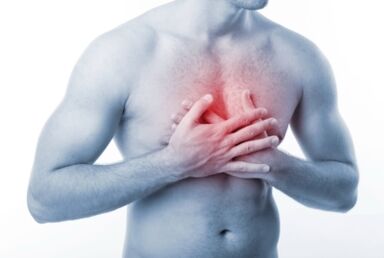
Chest pain is one of the common symptoms of thoracic osteochondrosis.Their appearance is associated with the following factors:
- Dysfunction of the organs in the thoracic region due to inflammation of the joints.
- Degenerative processes and atrophy at the junction of the spine and ribs.
- Increased load on the spine.
- Inflammatory processes in muscles.
One of the signs of osteochondrosis is the feeling of trembling in the chest, causing pain..Although from a physical point of view this area of the spine is considered the strongest, it can quite easily be affected by a disease process.
Reference!A sharp, sharp pain in the chest is called dorsago.This often occurs when the patient suddenly changes position after being stationary for a long period of time.
Mechanism of appearance of the syndrome
Under increased loads and other factors provoking osteochondrosis, the bone tissues of the spine are gradually deformed.Intervertebral discs slowly deteriorate and pathological growths appearcalled osteophytes.
When the patient moves, these growths cause the vessels in the spinal cord to become pinched.The further development of degenerative processes leads to a deterioration of blood circulation, including in the chest.Communication with the nervous system is disrupted.
As osteochondrosis progresses, the pressure increases.As a result, the pain also becomes stronger.Its location is determined by the area in which degenerative processes occur.
Signs of GOP pathology
The main symptoms that manifest osteochondrosis of the thoracic spine (OS) are:
- pain in the chest area, which is worse at night;
- pain between the shoulder blades, manifested when bending the arms and torso;
- pain when breathing;
- pain in the area below the ribs during movement.
Let's look at what other symptoms exist, whether the chest or stomach can hurt, where the pain goes, whether the arms are affected in any way.
Additional symptoms include::
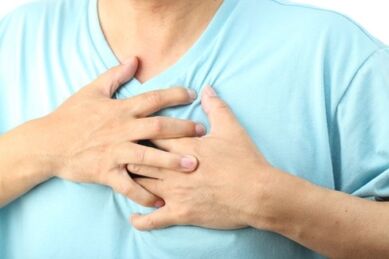
- Chest pain.With osteochondrosis of the thoracic region, pain in the sternum is the main symptom.They may feel like heart pain, which can make diagnosis difficult.Pain in the lower back, sides and abdominal cavity is also possible.
- Feeling of a lump in the chest.Also common.The feeling of a lump in the chest is associated with pinched nerve endings.When this happens, it is important not to panic, as the symptom is neurological in nature and the situation can get even worse.
- Headaches.Headaches are more common with cervical osteochondrosis, but they can also be felt with thoracic osteochondrosis.Its appearance is associated with circulatory disorders.
- Between the shoulder blades.Sometimes the pain appears only in the interscapular area.Usually in this case it is associated with breathing.
- Burning.There may also be a burning sensation in the chest.It is generally accompanied by compressive pain and radiates towards the heart.Symptoms can resemble a heart attack, which is frightening for patients.
- My hands are going numb.Numbness of the limbs is also possible in cases of osteochondrosis.It is associated with circulatory problems.
- Give to the stomach area.If osteochondrosis affects the thoracic region, pain may radiate to the stomach region.Disturbances in the functioning of the gastrointestinal tract, the development or aggravation of pathologies of internal organs are also possible.The cause of the pain is most often compression of the nerves that connect the back to the gastrointestinal tract and the pelvis.
Discomfort can easily be confused with pain due to diseases of the digestive system.
- Hernia pain.With osteochondrosis, pressure occurs on the cartilaginous layers between the vertebrae and the cartilage becomes deformed.As a result, bone tissue grows and a hernia appears.As it exceeds, it contributes to irritation of nerve endings, which can cause pain in various parts of the body.
- Painful swallowing.If the disease is localized in the upper region of the sternum, pain may appear in the pharynx or esophagus.There's a lump in my throat.There may also be problems swallowing, especially when eating foods that are large or irritating to the lining of the esophagus.
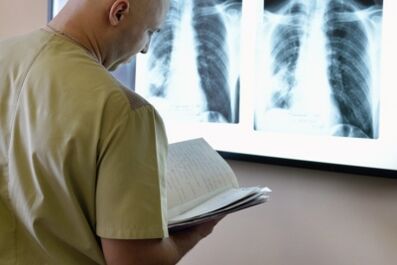
Diagnosis
The following tests are used to diagnose osteochondrosis::
- examination by an orthopedist and surgeon;
- chest x-ray;
- ECG;
- Ultrasound of the abdominal cavity and thorax;
- general urine and blood tests;
- gastroduodenoscopy (examination of the stomach and intestines using a probe).
These techniques make it possible to confirm that the symptoms that appear are a consequence of osteochondrosis and not of another disease.
What is pain in the sternum with chondrosis of the sternum often confused with?
Sternal pain associated with osteochondrosis is most often confused with heart pain..They can also be confused with pain syndrome due to digestive system disorders.To establish the exact cause, the doctor carries out a differential diagnosis.
How is it different from a heart condition?
Pain associated with cervical osteochondrosis is similar to pain associated with cardiac pathologies.It is quite difficult for the patient to distinguish them and an electrocardiogram is used for diagnosis.If we talk about heart disorders, pain is easily relieved by glycerol trinitrate, while in osteochondrosis it does not relieve the symptoms.
With VSD there is an extra feeling:
- tachycardia and bradycardia;
- there is a feeling of fear;
- constant weakness and fatigue.
The pain is usually dull and aching, while with osteochondrosis it is compressive in nature.
How long do they last?
The pain may come in short bursts and last for several minutes.If we are talking about long-term pain syndrome, it may not disappear for 2-3 weeks.Significant symptoms usually last up to 5 days.
Are there any differences in symptoms between men and women?

The main symptoms of thoracic osteochondrosis do not differ between men and women.
However,It is more difficult to diagnose pathology in women due to hormonal characteristics.In young patients, it is subject to constant fluctuations.During menopause, the synthesis of certain hormones decreases, which can cause a number of pathologies requiring differential diagnosis.
In humans, the disease has a typical course, which allows it to be quickly identified and started treatment.
Treatment methods
Methods for treating the disease itself and chest pain should be chosen by a doctor.As a rule, complex therapy is required.
Drugs
Medications are currently the main method of treating osteochondrosis.Here are some remedies that may be indicated in cases of chest injuries::
- Nonsteroidal anti-inflammatory drugs that help eliminate inflammation.
- Chondroprotectors aimed at restoring the structure of damaged cartilage.
- Muscle relaxants that provide relaxation and muscle tone.
- Preparations for normalizing metabolic processes.
- Vitamin and mineral complexes.
Medicines can be prescribed in the form of tablets or injections.In case of severe pain, a therapeutic blockade can relieve the patient's condition.
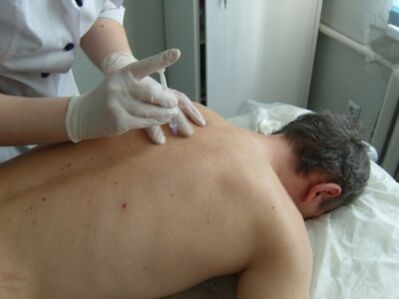
Intra-articular injections
In some cases, it is necessary to introduce chondroprotectors directly into the affected joint.
Medicines help:
- restore the elasticity of the discs between the vertebrae;
- saturate affected tissues with essential nutrients;
- prevent their further destruction.
Blockade
Therapeutic blockade aims to quickly relieve pain and inflammation, as well as the patient's return to normal mobility.It can be articular and periarticular.In the latter case, the drug is not injected into the joint itself, but into the tissues located near it.This method is gentler and no less effective, but the result appears more slowly.
Gymnastics
Exercises help strengthen muscles, normalize the functioning of ligaments, muscles and joints, and reduce static tension on the spine.They must be selected by a doctor.As a rule, gymnastics is prescribed only at the stage of remission.
Attention!During exercises, the pain should not intensify.
What exercises to do for a hernia?
The doctor may prescribe special exercises for a hernia.It can be carried out exclusively when the pathological process subsides.An important condition is the absence of severe pain syndrome.
For this pathology, exercises with a stick are often recommended.Twists, turns and other simple movements aimed at working the thoracic region can be performed.
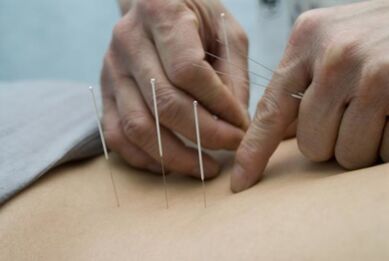
Physiotherapy
Physiotherapy for the treatment of thoracic osteochondrosis can be prescribed:
- vibrating massages;
- UVT;
- acupuncture;
- mud therapy and light therapy.
These methods help relieve pain, speed up tissue repair, and relieve inflammation.
Massage
The main goal of therapeutic massage is to improve blood circulation, which has a beneficial effect on the treatment of the disease.
Manual therapy
Manual therapy is carried out only after a complete examination of the patient.It is contraindicated in cases of acute pain.Its main task is to eliminate spinal deformation, restore blood circulation and improve motor activity.
Manual therapy is not used:
- with high blood pressure;
- after spinal injuries;
- in the acute stage of chronic pathologies;
- with vascular lesions;
- infectious diseases.
It is also contraindicated when:
- oncology;
- damage to the central nervous system;
- increased intracranial pressure.
The therapeutic effect consists of restoring muscle function, improving blood circulation in spinal tissues and normalizing metabolic processes.
Hood
This method involves stretching the muscles and ligaments, which helps widen the distance between the vertebrae, eliminating pinched nerves.As a result, the pain syndrome is significantly reduced.
Folk remedies
Folk remedies cannot replace traditional medicine, but they can complement treatment.The most popular recipes are:
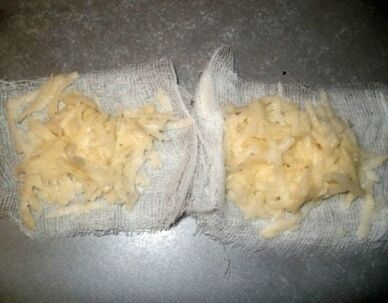
- Compresses made from raw potatoes.You need to grate the potatoes, mix them with honey in equal proportions, mix well.The composition is applied to the affected area, fixed like a compress and left for two hours.Then you need to wash off the paste with warm water.
- This recipe can be used both externally and internally.You need to take 50 grams of high-quality vodka, 150 grams of liquid honey, a small radish and four teaspoons of salt.Grate the potatoes and mix with the rest of the ingredients.
The gruel can be applied to the affected area with friction.You can also use the product as a dye.It is consumed twice a day, morning and evening, for a week.
- You can also relieve pain caused by thoracic osteochondrosis by rubbing 250 grams of sunflower oil and chopped fresh oregano.
How to relieve an attack?
Medications are usually used to stop an attack.In some cases, a drug blockade may be necessary.
Medications may be prescribed:
- anti-inflammatory drugs;
- chondroprotectors;
- muscle relaxers;
- nootropics;
- diuretics;
- B vitamins.
To normalize local blood circulation, a light massage can be performed.

Prevention
It is easier to prevent a disease than to treat it.To reduce the risk of occurrence or exacerbation of osteochondrosis,it is important to monitor your lifestyle.
- During sedentary work, you need to periodically take breaks and devote them to physical activity.
- It is also important to give up bad habits, control your posture, get enough sleep and avoid stress.
How to eat well when you are sick?
Good nutrition helps speed up the recovery process and prevent illness.The diet is based on:
- fish;
- meat;
- dairy products;
- legumes
It is also important that your diet includes fresh fruits and vegetables.Food should not be fried - it is better to boil, bake or steam it.
It is important to limit consumption:
- salt;
- spices;
- spices.
Caution is also required with:
- smoked meats;
- marinated dishes;
- candy.
If you are overweight, it is important to follow a diet aimed at losing weight.You need to drink plenty of water.But you should not get carried away with coffee - it tends to remove calcium from the body, which is harmful to osteochondrosis.It is also recommended to avoid alcoholic beverages.
Expert Recommendations
Additionally, experts give the following recommendations:

- To avoid an exacerbation, try to be careful when exercising.It is important to avoid intense stress, fatigue and hypothermia.
- You should watch out for any additional symptoms.This will help to diagnose the disease in a timely manner.These include headaches, dizziness, nausea and breathing problems.
- You should not prescribe medications yourself - a doctor should select them taking into account the severity of the pathological process and existing symptoms.
- In case of acute pain, it is recommended to call an ambulance or consult a neurologist.
Painkillers and topical analgesics may be used to relieve pain.
- In case of exacerbation, bed rest should be observed.Activity should be minimal.
- If pain attacks are caused by a hernia, wearing a special corset is necessary.In some cases, surgery is not possible.It is carried out after a detailed diagnosis and exclusion of other pathologies.
- It is important to adopt the correct position while sleeping.It is recommended to sleep on your back using a firm, dense mattress.When the vertebrae return to their normal physiological position, the discomfort disappears.
Thoracic osteochondrosis is not only an unpleasant, but also dangerous disease.This requires rapid and comprehensive treatment.The doctor decides what the therapy should be.The patient must follow all recommendations received from him and lead an appropriate lifestyle.
























